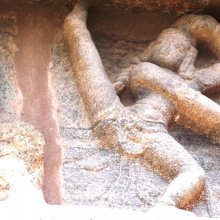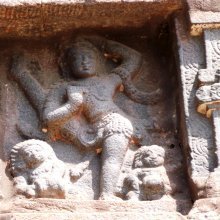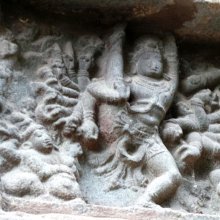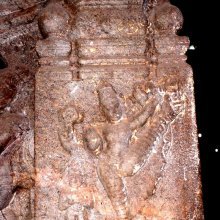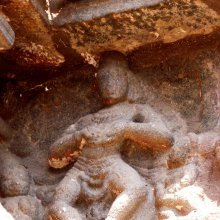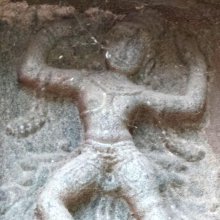Dandapada, Daṇḍapādā, Danda-pada, Daṇḍapāda, Damdapada: 4 definitions
Introduction:
Dandapada means something in Hinduism, Sanskrit. If you want to know the exact meaning, history, etymology or English translation of this term then check out the descriptions on this page. Add your comment or reference to a book if you want to contribute to this summary article.
Images (photo gallery)
In Hinduism
Natyashastra (theatrics and dramaturgy)
Source: Wisdom Library: Nāṭya-śāstra1) Daṇḍapāda (दण्डपाद).—One of the 108 karaṇas (minor dance movement) mentioned in the Nāṭyaśāstra chapter 4. The instructions for this daṇḍapāda-karaṇa is as follows, “after the Nūpura Cārī, Daṇḍapāda Cārī should be observed and the Āviddha hand should be shown quickly.”.
A karaṇa represents a minor dance movements and combines sthāna (standing position), cārī (foot and leg movement) and nṛttahasta (hands in dancing position).
2) Daṇḍapāda (दण्डपाद) also refers to one of the twenty maṇḍalas, according to the Nāṭyaśāstra chapter 12. The Daṇḍapāda-maṇḍala is classified as a ākāśa, or “aerial”, of which there are ten in total. A maṇḍala is a combination of cārīs (“dance-steps”), which refers refers to the simultaneous movement of the feet (pāda), shanks (jaṅghā) and the hip (ūru). From these cārīs proceed dance as well as movements in general.
Source: archive.org: Natya Shastra1) Daṇḍapādā (दण्डपादा).—A type of aerial (ākāśikī) dance-step (cārī);—Instructions: the foot in the Nūpura-[pādikā] Cārī to be stretched and quickly to turn.
2) Daṇḍapāda (दण्डपाद).—A type of maṇḍala (series of cārīs) classified as aerial (ākāśa);—Instructions:
1) The right foot to be moved in the janitā and the daṇḍapāda-cārīs,
2) The left foot in the sūcī and the bhramarī-cārīs (the latter by turning the trika),
3) The right foot in the ūrūdvṛttā-cārī and the left foot in the alātā-cārī,
4a) The right foot in the pārśvakrāntā-cārī and the left foot successively in the bhujaṅgatrastā and the atikrāntā-cārīs,
4b) to meet the right foot in the daṇḍapāda-cārī and the left foot successively in the sūcī and the bhramarī-cārīs (the latter by turning the trika).

Natyashastra (नाट्यशास्त्र, nāṭyaśāstra) refers to both the ancient Indian tradition (shastra) of performing arts, (natya—theatrics, drama, dance, music), as well as the name of a Sanskrit work dealing with these subjects. It also teaches the rules for composing Dramatic plays (nataka), construction and performance of Theater, and Poetic works (kavya).
Languages of India and abroad
Sanskrit dictionary
Source: Cologne Digital Sanskrit Dictionaries: Edgerton Buddhist Hybrid Sanskrit DictionaryDaṇḍapāda (दण्डपाद).—pl., name of a group of nāgas: Mahā-Māyūrī 221.17.
Sanskrit, also spelled संस्कृतम् (saṃskṛtam), is an ancient language of India commonly seen as the grandmother of the Indo-European language family (even English!). Closely allied with Prakrit and Pali, Sanskrit is more exhaustive in both grammar and terms and has the most extensive collection of literature in the world, greatly surpassing its sister-languages Greek and Latin.
Kannada-English dictionary
Source: Alar: Kannada-English corpusDaṃḍapāda (ದಂಡಪಾದ):—[noun] (dance) one of the movements above the ground, in which one foot is placed on the ground and bending the knee and moving the other foot forward quickly and then placed on the ground.
Kannada is a Dravidian language (as opposed to the Indo-European language family) mainly spoken in the southwestern region of India.
See also (Relevant definitions)
Partial matches: Pada, Danda, Pata, Tanta.
Ends with: Parshvadamdapada.
Full-text: Aparajita, Vamaviddha, Vihrita, Atikranta, Mandala.
Relevant text
Search found 6 books and stories containing Dandapada, Daṇḍapādā, Danda-pada, Daṇḍapāda, Damdapada, Daṇḍa-pāda, Daṃḍapāda; (plurals include: Dandapadas, Daṇḍapādās, padas, Daṇḍapādas, Damdapadas, pādas, Daṃḍapādas). You can also click to the full overview containing English textual excerpts. Below are direct links for the most relevant articles:
Natyashastra (English) (by Bharata-muni)
Gati in Theory and Practice (by Dr. Sujatha Mohan)
Performance of Gati through Maṇḍalas < [Chapter 2 - Concept and technique of Gati]
Gait identified in the martial arts of India < [Chapter 4 - Practice of Gati]
The history of Andhra country (1000 AD - 1500 AD) (by Yashoda Devi)
Part 56 - The Later Gajapatis < [Chapter XIII - The Dynasties in South Kalinga]
Trishashti Shalaka Purusha Caritra (by Helen M. Johnson)
Appendix 6.2: new and rare words < [Appendices]
Part 4: Attacks by Saṅgamaka < [Chapter IV - Mahāvīra’s second period of more than six years]
The backdrop of the Srikanthacarita and the Mankhakosa (by Dhrubajit Sarma)
Part 7 - Flora and fauna (found in the Śrīkaṇṭhacarita) < [Chapter IV - Socio-cultural study of the Śrīkaṇṭhacarita]
Part 7 - Literary genius of Maṅkhaka < [Chapter II - The Śrīkaṇṭhacarita]
The Vishnu Purana (by Horace Hayman Wilson)
